Overall, the Canadian economy has started to return to the pre-pandemic levels of major economic indicators by the end of 2021. Similarly, economic indicators for BC have returned to, or exceeded, levels from before the pandemic. As of the end of Q4, more than 77.0% of the population eligible for their COVID-19 vaccine (individuals five years-old and older) have received two doses.
BC remained in Step 3 of its Restart Plan and has decided to postpone moving to Step 4 for the foreseeable future. Despite the majority of our population being vaccinated in BC, rising COVID-19 case counts at the end of Q4, especially of the Omicron variant, resulted in further restrictions through January 31, 2022.
As mentioned in previous posts, Canada and BC has been offering financial support to aid people and businesses recover from the uncertain economic environment. This article gives readers an update from Q3 2021 to Q4 2021 of selected economic indicators. The indicators discussed herein are both indicative and representative of the Canadian, BC, and regional economies.
Labour Market
The labour force refers to the supply (employees) and demand (employers) for labour. The number of labour force participants and the unemployment rate are indicators that highlight the material changes that took place in the labour market from Q3 2021 to Q4 2021.
The federal government has initiated several programs to support employers and employees impacted by COVID-19. On October 24, 2021, the Tourism and Hospitality Recovery Program and the Hardest-Hit Recovery Program replaced the Canada Emergency Wage Subsidy (CEWS) and the Canada Emergency Rent Subsidy (CERS). The Government extended the Canada Recovery Hiring Program and the Canada Recovery Sickness Benefit (CRSB) to May 7, 2022 at the end of Q4.
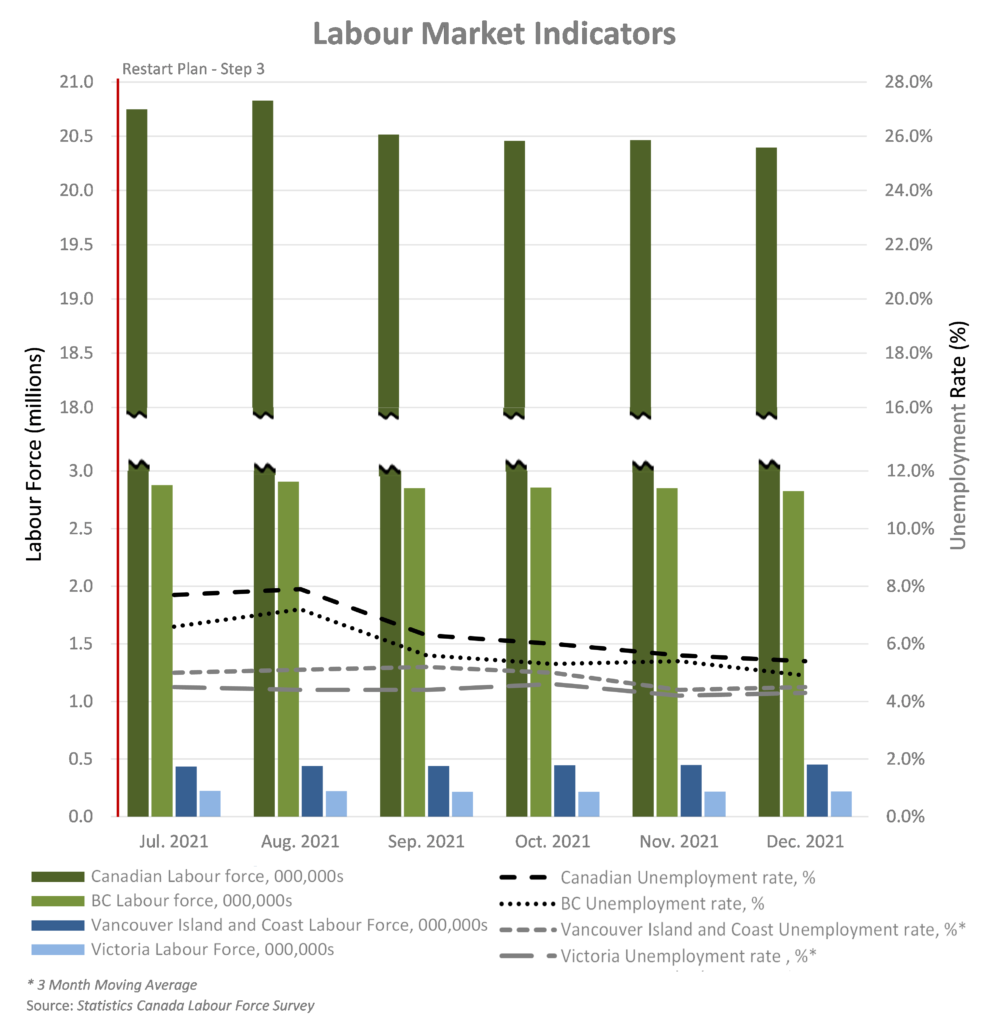
Before the impact of COVID-19, Canada was experiencing a steady increase in labour force participants. As of December 31, 2021, the Canadian labour force consisted of 20.4 million people, a decrease of approximately 119,000 participants since the prior quarter. At the beginning of Q4, the national unemployment rate was 6.3% which then decreased to 5.4% by the end of the quarter, 0.5% lower than the pre-pandemic rate of 5.9%. TD Economics (TDE) forecasts that Canada’s unemployment will remain in the range of 5.4% through 2023.
BC’s unemployment rates reflected the national trend for Q3, decreasing from 5.6% to 4.9% during the period. The quarter low was 0.1% lower than the province’s February 2020 rate of 5.0% and BC was forecast to lead the country in labour force growth and unemployment rate metrics. BC’s job vacancy rate was the highest among all the provinces through Q3; however, strong inter-provincial immigration to BC is expected to help fill vacant employment opportunities.
The unemployment rate for Vancouver Island and Coastal regions also decreased, from 5.2% to 4.5%, which was 0.8% lower than pre-pandemic rates. In Victoria, the unemployment rate decreased throughout the quarter from 4.4% to 4.3%, which was still 0.8% higher than the pre-pandemic rate of 3.5%..
Gross Domestic Product (GDP)
TTD Economics (TDE) re-forecasts Canada’s real GDP year-over-year growth rate to 4.5%, which was lower than their Q3 forecast of 4.9% growth due mainly to an overall decrease in expectations of global GDP growth, as a result of supply chain distribution issues. Nevertheless, provincial, and territorial governments lifted public health restrictions during Q4 which resulted in strong quarterly growth of 5.4%.
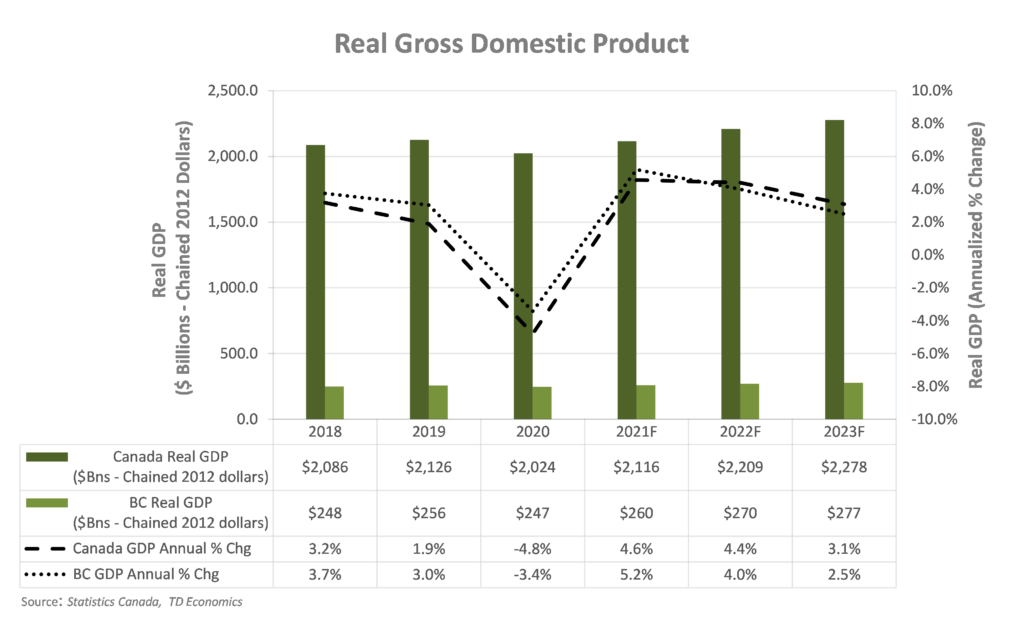
Significant flooding in BC during the quarter resulted in a near-term setback to the province’s recovery as supply chains were disrupted further. As a result, TDE also forecast slower growth for the BC economy to a real GDP increase of 5.2% for 2021, which is 0.6% lower than TDE’s prediction earlier in the year. In dollar terms, the provincial GDP was forecast to increase to $259.8 billion, which is $1.5 billion lower than was forecast in the prior quarter. The recovery to pre-COVID-19 business activity has spanned the professional/scientific, trade, manufacturing, natural resource, and public-sector industries.
Housing Market
Housing starts and average residential prices reflect market indicators with strong correlation to both the construction and real estate industries. BC’s housing starts dropped by 16.0% during 2020. The BC Real Estate Association (BCREA) forecasts an increase of 26.2% for 2021 (Q3 forecast: 18.5%) followed by a decrease of 11.6% for 2022 (Q3 forecast: 12.8%).
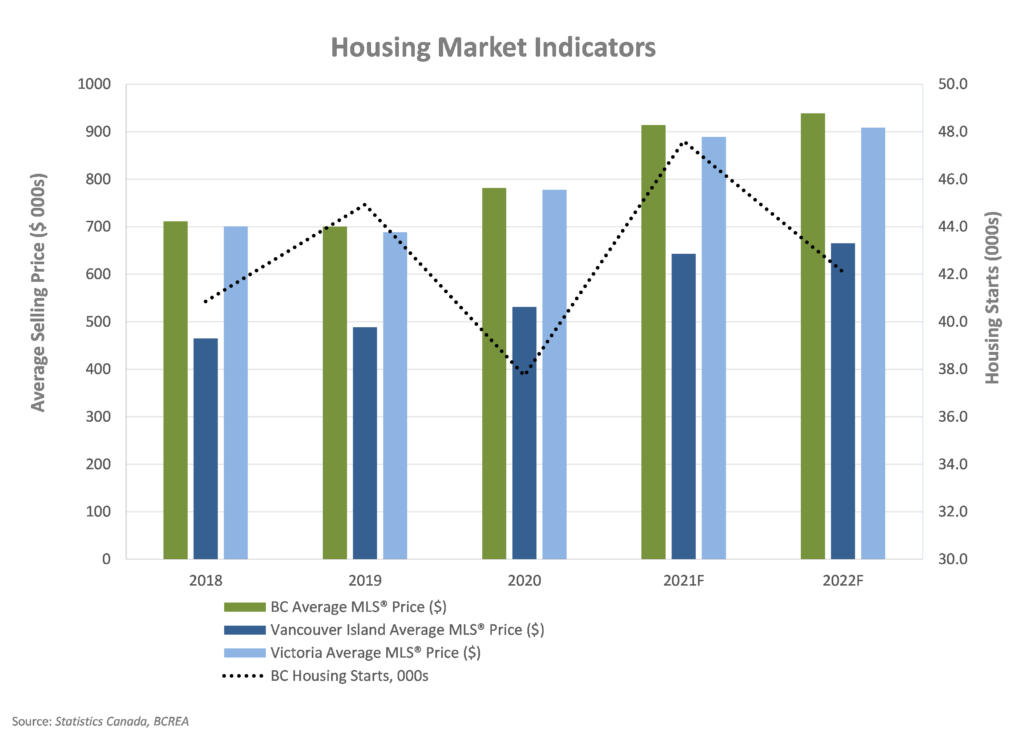
Average residential prices increased further in Q4 and BCREA forecasts an increase of 17.0% in the average MLS® price for single family dwellings for 2021 to an average price of $914,400 (Q3: 16.6% and $911,300, respectively). Although, BCREA has downgraded their growth forecast for 2022 to 2.7% (Q3: 2.9%), they are predicting a slightly higher average price of $938,900 (Q3: $937,300). BC ranked among the most expensive housing markets in Canada as demand continues to widely surpass supply in the province. BCREA forecasts an increase in the average MLS® prices for single family dwellings in the Victoria area of 14.3% for 2021 and 2.2% for 2022 and 2022.
Interest Rates & Foreign Exchange
The Bank of Canada (BoC) is expected to maintain the overnight target rate at its lower limit of 0.25% until its inflation objective is sustainably achieved. The last time the target rate was this low was in 2009 following the financial crisis. Nevertheless, TDE forecasts increases in the target rate for 2022 and 2023.
The low overnight target rate has led to a significant decrease in the prime rate, so Canadian business owners can obtain lower cost financing and consider refinancing existing debt at lower rates. As a result of the series of rate cuts, the average prime rate was 2.45% for Q3. The prime rate is likely to increase in step with the target overnight rate.

The Bank of Canada (BoC) expected inflation to be higher than its target of 2.00% for the first half of 2022 but expected it to ease back towards 2.00% during the second half of the year. TDE forecasts inflation to be 3.30% for 2021 and 3.60% for 2022, which is higher than the BoC target for each of these years. For 2023, TDE predicts that inflation will decrease to 2.20%, which approaches the federal benchmark.
The Q3 forecast for the average annual USD to CAD exchange rate for 2021 of $0.81 and for 2022 of $0.80, remains unchanged from estimates earlier in the year. This exchange rate strongly correlates to oil prices, and over the long-term the value of the Canadian dollar relative to the US dollar fluctuates in-step with oil price changes.
Crude Oil Prices
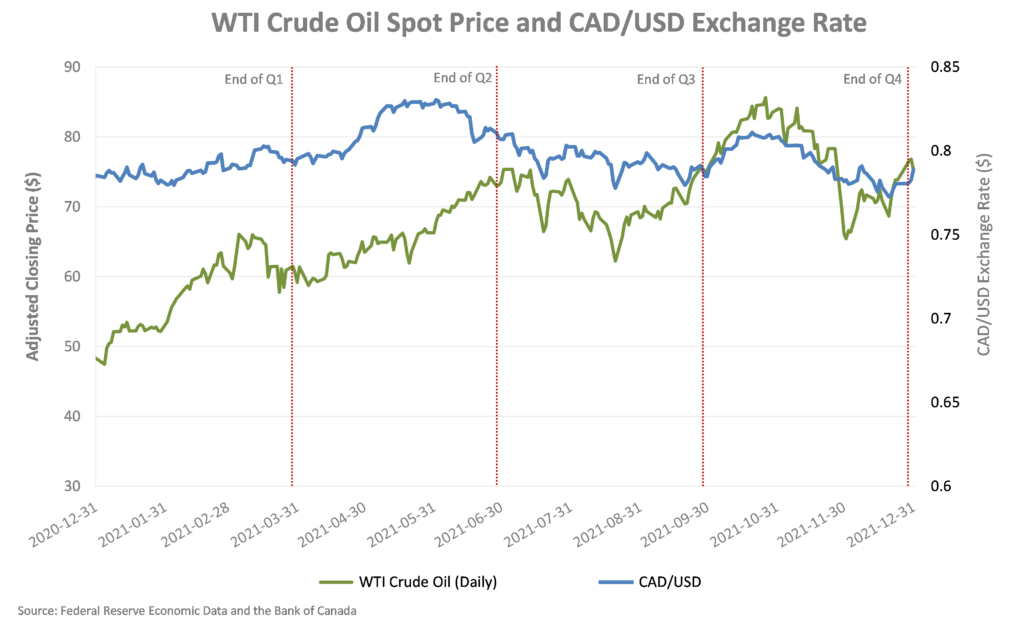
Canada has the 4th largest proven oil reserves in the world. As a net oil exporter, the Canadian economy is heavily impacted by the price of crude oil, with the greatest impact felt in Canada’s major oil producing provinces. The majority of Canadian crude oil production is in Alberta (81.0%), Saskatchewan (10.0%), and Newfoundland and Labrador (6.0%).
In North America, the West Texas Intermediate (WTI) crude oil spot price is the benchmark oil price. Historical WTI crude oil daily spot prices at the end of Q4 were:

Over the course of Q4, WTI oil prices ranged from $65.44 (December 1) to $85.64 (October 26), which is higher than historical averages. The International Energy Agency (IEA) predicts global oil demand to return to their pre-pandemic levels by the end of 2022. On November 3, 2021, the Federal Government announced at the UN Climate Conference in Scotland that Canada has committed to a cap on greenhouse gas emissions produced by the Canadian oil and gas industry. The current Liberal government indicated plans to force emissions down to net zero by 2050. In 2015, Alberta, the country’s biggest crude oil producer, legislated a provincial carbon cap of 100 megatonnes; however, this is well above current production of 70 megatonnes.
Capital Markets
The international response to COVID-19 at the beginning of March 2020 negatively impacted the current and anticipated operations of many privately-owned and publicly traded North American businesses. For publicly traded companies, this impact is evident in changes in capital markets during the period. On March 12, 2020 both the Dow Jones Industrial Average (DJIA) and S&P/TSX Composite Index witnessed the greatest single-day percentage drop since the stock market crashes of 1943 and 1987, respectively. By the start of 2021 both indices had recovered to their pre-COVID-19 levels, and as of September 30, 2021, the year-to-date percentage gain for the Dow Jones Industrial Average (DJIA) and S&P/TSX Composite index was 20.4%. Both indices reached record all-time highs in Q4.
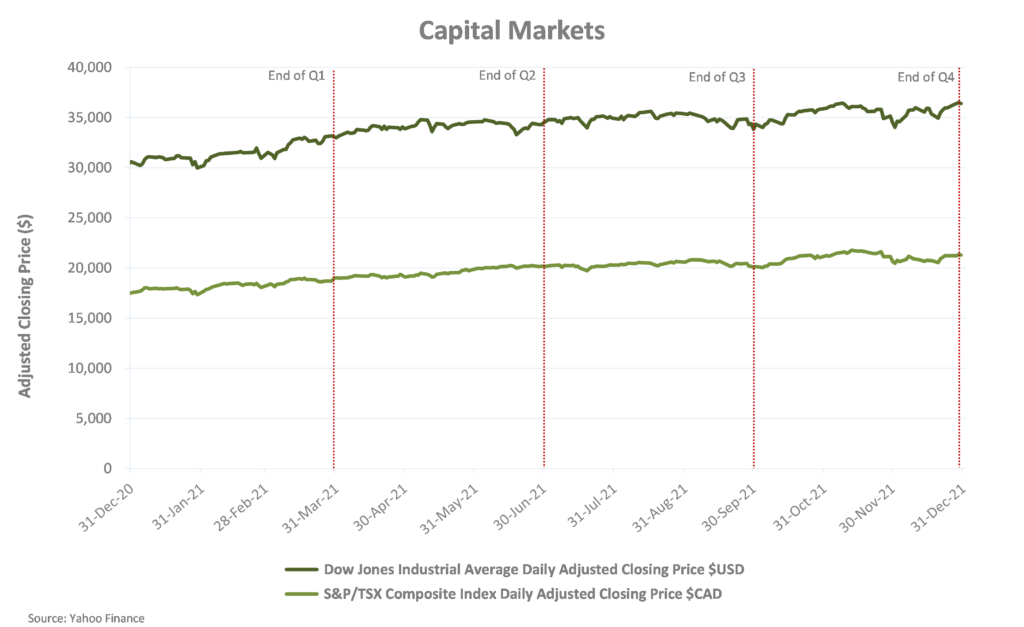
Although capital markets have fully recovered, it is important to note these indicators are based on forward looking assumptions and analysis, which have largely optimistic. As covered in the other sections of this post, overall, global and Canadian economies are still struggling to overcome the impact of COVID-19.
Moving into first quarter of 2022, restrictions imposed in late December 2021 are set to expire on January 31, 2022. As of December 31, 2021, 87.3% of the eligible BC population had received their first dose COVID-19 vaccination, and 81.8% had received their second dose. Nevertheless, it will be difficult to gauge the full impact of COVID-19 on the Canadian, BC, and regional economies until the world has recovered from the pandemic. The metrics analysed indicate an optimistic outcome, with the current economic forecast indicating near-recovery by the end of 2021. Business owners will continue to benefit from the fiscal stimulus provided by various levels of government and refinancing their existing debts with the historically low interest rates.
A glossary of all defined terms can be found here.
[1] In 1977, the TSE 300 index was created, comprising of the 300 largest companies on the TSX. In 2002, Standard and Poor’s took responsibility of the index and renamed it the “S&P/TSX Composite Index”.
